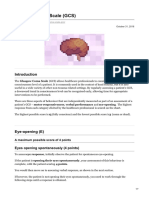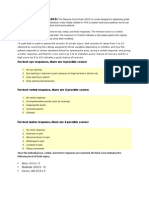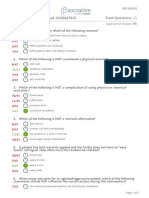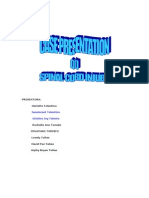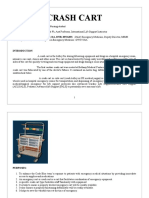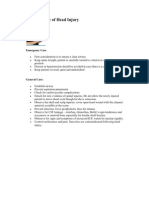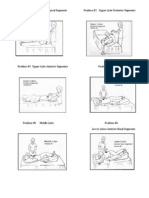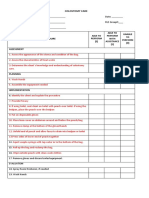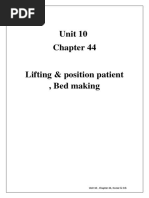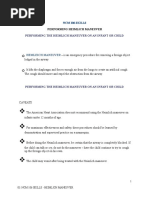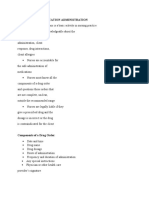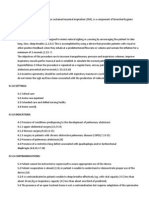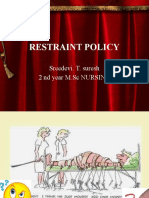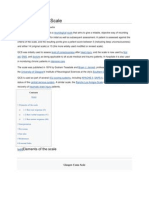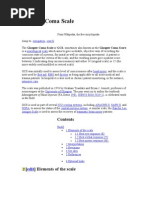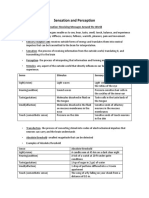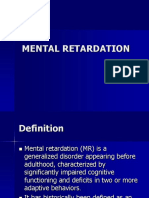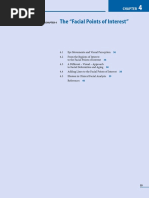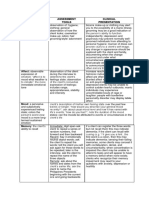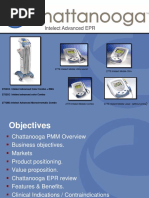Glasgow Coma Scale
Glasgow Coma Scale
Uploaded by
Lanie Reyes de GuzmanCopyright:
Available Formats
Glasgow Coma Scale
Glasgow Coma Scale
Uploaded by
Lanie Reyes de GuzmanCopyright
Available Formats
Share this document
Did you find this document useful?
Is this content inappropriate?
Copyright:
Available Formats
Glasgow Coma Scale
Glasgow Coma Scale
Uploaded by
Lanie Reyes de GuzmanCopyright:
Available Formats
Glasgow Coma Scale (GCS) Definition A Glasgow Coma Scale (GCS) is the most widely used scoring system
that determines the level of consciousness of an individual with a suspected or confirmed brain injury. Use of the GCS scale does not take place an in-depth neurologic assessment Purpose This scale is used to: 1. Address the three areas of neurologic functioning 2. Gives an overview of the patients level of consciousness (LOC) 3. Evaluates the neurologic status of patients who have had a head or brain injury This scale is not only used after a traumatic head or brain injury but is also utilized in first aid, Emergency medical services (EMS), acute cases and for the monitoring of chronic patients in intensive care units. What is assessed or measured in GCS? Use of the Glasgow Coma Scale does not take place an in-depth neurologic assessment rather it provides an evaluation of the patients responses in the following areas: 1. Eye-opening responses 2. Motor responses 3. Verbal responses The three areas are further divided into different levels where a number is assigned to each of the possible responses within the categories. A high number means that the response is normal while a low one denotes impairment of neurologic function. The calculated total figure indicates the severity of the coma a patient is experiencing. The lowest score is 3 (least responsive) suggests or reflects that a patient is in a deep coma, while the highest score of 15 (most responsive) means that the patient is fully intact. The Glasgow Coma Scale
Characteristic Eye Opening(E)
Best Motor Response (M)
Best Verbal Response (V) (arouse patient with painful stimuli if necessary)
Response Spontaneous 4 To verbal command or speech 3 To pain 2 Does not open eyes to painful 1 stimuli or no response Obeys commands 6 Localizes pain; pushes stimuli 5 away Flexes and withdraws 4 Abnormal flexion (decorticate 3 response) Abnormal extension response 2 (decerebrate response) No motor response 1 Oriented and converses 5 Disoriented and converses 4 (confused conversation) Uses inappropriate words 3 Makes incomprehensible sounds 2 No verbal response 1 Total: E + M + V 3 to 15
Score
Interpretation of Scores Individual categories or elements as wells as the sum of the score are important. The score is expressed in this form for a client who is most responsive: GCS 15 = E4 V5 M6 at 14:00 This means that the clients GCS total score is 15 where the Eye Opening is scored 4, Motor response of 6 and verbal response of 5 as of 2:00 in the afternoon or 14:00 in a 24-hour time format. Coma is suspected if the GCS score is equal to or less than 7. A score equal to 8 or less could also suggest a severe brain injury. GCS 9-12 indicates moderate brain injury and more than 13 denotes minor brain injury. Coma with the use of GCS is defined as not opening the eyes, not obeying commands and no verbal response.
y y y y y
y y y y y
y y y y y y
y y
y y y y
y y y y y y y y
The Glasgow Coma Scale (GCS) is used to assess level of consciousness in a wide variety of clinical settings, particularly for patients with head injuries (NICE, 2007). In this practical procedure, assessment of the patient's best eye-opening response will be outlined and discussed, and, in next week's article, assessment of the patient's best verbal and motor responses will be described. What the GCS assesses The GCS assesses the two aspects of consciousness: Arousal or wakefulness: being aware of the environment; Awareness: demonstrating an understanding of what has been said. The 15-point scale assesses the patient's level of consciousness by evaluating three behavioural responses: Eye opening; Verbal response; Motor response. Eye opening Assessment of eye opening involves the evaluation of arousal (being aware of the environment): Score 4: eyes open spontaneously; Score 3: eyes open to speech; Score 2: eyes open in response to pain only, for example trapezium squeeze (caution if applying a painful stimulus); Score 1: eyes do not open to verbal or painful stimuli. Record 'C' if the patient is unable to open her or his eyes because of swelling, ptosis (drooping of the upper eye lid) or a dressing. Verbal response Assessment involves evaluating awareness: Score 5: orientated; Score 4: confused; Score 3: inappropriate words; Score 2: incomprehensible sounds; Score 1: no response. This is despite both verbal and physical stimuli. Record 'D' if the patient is dysphasic and 'T' if the patient has a tracheal or tracheostomy tube in situ. Motor response Assessment of motor response is designed to determine the patient's ability to obey a command and to localise, and to withdraw or assume abnormal body positions, in response to a painful stimulus (Adam and Osborne, 2005): Score 6: obeys commands. The patient can perform two different movements; Score 5: localises to central pain. The patient does not respond to a verbal stimulus but purposely moves an arm to remove the cause of a central painful stimulus; Score 4: withdraws from pain. The patient flexes or bends the arm towards the source of the pain but fails to locate the source of the pain (no wrist rotation); Score 3: flexion to pain. The patient flexes or bends the arm; characterised by internal rotation and adduction of the shoulder and flexion of the elbow, much slower than normal flexion; Score 2: extension to pain. The patient extends the arm by straightening the elbow and may be associated with internal shoulder and wrist rotation; Score 1: no response to painful stimuli. Painful stimulus A true localising response to pain involves the patient bringing an arm up to chin level. Painful stimuli that can elicit this response include trapezium squeeze (Fig 4), suborbital ridge pressure (Fig 5) (not recommended if there is a suspected/confirmed facial fracture) and sternal rub (caution, not recommended in some organisations) (Fig 6) (Jevon, 2007). The procedure Explain the procedure to the patient. Ascertain the patient's acuity of hearing. Ideally, use an interpreter if the patient does not speak English. Check the patient's notes for any medical condition that may affect the accuracy of the GCS, for example previous stroke, affecting the movement of the patient's arms (Fig 1). Check the neurological observation chart for the GCS scale (Fig 2). Check if the patient opens their eyes without the need to speak or to touch them; if the patient does, then the score is 4E. If the patient does not open their eyes, talk to them (Fig 3). Start off with a normal volume and speak louder if necessary. If they now open their eyes, the score is 3E. If the patient does not open their eyes to speech, administer a painful stimuli, for example trapezium squeeze (using the thumb and two fingers grasp the trapezius muscle where the neck meets the shoulder and twist ) (Fig 4). Or apply suborbital pressure (locate the notch on the suborbital margin and apply pressure to it) (Fig 5). An alternative is the sternal rub (using the knuckles of a clenched fist to apply grinding pressure to the sternum; not recommended for repeated assessment) (Fig 6). If the patient opens their eyes to a painful stimulus record the score as 2E (Dougherty and Lister, 2005). If the patient does not respond, then the score is 1E.
You might also like
- Glasgow Coma Scale: Presented by Pankaj Singh Rana Nurse Practitioner in Critical CareDocument17 pagesGlasgow Coma Scale: Presented by Pankaj Singh Rana Nurse Practitioner in Critical CareAnisya AbabeliaNo ratings yet
- Neurological AssessmentDocument10 pagesNeurological AssessmentKristine AlejandroNo ratings yet
- Heimlich Maneuver Checklist LatestDocument1 pageHeimlich Maneuver Checklist LatestPrince D. JacobNo ratings yet
- Fundamental of NursingDocument1 pageFundamental of Nursingioana_ciobincanNo ratings yet
- Best Practices Procedure For Instillation of Eye DropsDocument1 pageBest Practices Procedure For Instillation of Eye DropsRahul ModiNo ratings yet
- Gastric LavageDocument2 pagesGastric LavageIrish Eunice FelixNo ratings yet
- Peripheral Artery Disease: Nikhil Vaishnav M.Sc. (Nursing)Document70 pagesPeripheral Artery Disease: Nikhil Vaishnav M.Sc. (Nursing)Dimpal ChoudharyNo ratings yet
- Sub - Medical Surgical Nursing: Assignment On Neurological AssessmentDocument11 pagesSub - Medical Surgical Nursing: Assignment On Neurological Assessmentkamini Choudhary100% (1)
- Glasgow Coma Scale GCSDocument7 pagesGlasgow Coma Scale GCSSSNo ratings yet
- GlasGow Coma ScaleDocument3 pagesGlasGow Coma ScaleNathanielle Dae AquinoNo ratings yet
- Using The 7 Minute Exercise (From Barry Mcdonagh'S Panic Away)Document2 pagesUsing The 7 Minute Exercise (From Barry Mcdonagh'S Panic Away)musaa sarrNo ratings yet
- NSO Glasgow Coma ScaleDocument3 pagesNSO Glasgow Coma Scaleanon_657718264No ratings yet
- Glasgow Coma ScaleDocument2 pagesGlasgow Coma ScaleAlas CuatroNo ratings yet
- Heimlich ManueverDocument11 pagesHeimlich Manueverea013100% (1)
- Coronary Care Unit/ Cardiac Care Unit: Patient MonitorsDocument3 pagesCoronary Care Unit/ Cardiac Care Unit: Patient MonitorsPhoebe Kyles Camma100% (2)
- Physical Assessment of Cardiovascular SystemDocument31 pagesPhysical Assessment of Cardiovascular SystemaagNo ratings yet
- Restraint Soctrative With AnswersDocument5 pagesRestraint Soctrative With AnswersKarren FernandezNo ratings yet
- Spinal Cord InjuryDocument50 pagesSpinal Cord InjuryVINCHRISTINENo ratings yet
- Procedure Checklist Chapter 21: Using RestraintsDocument1 pageProcedure Checklist Chapter 21: Using RestraintsjthsNo ratings yet
- Demonstration On Chest Physiotherapy DefinitionDocument3 pagesDemonstration On Chest Physiotherapy Definitiondileep0% (1)
- Cataract SurgeryDocument14 pagesCataract SurgeryRenato AbellaNo ratings yet
- Glasgow Coma ScaleDocument2 pagesGlasgow Coma Scalejean thereseNo ratings yet
- CRASH CART NewDocument11 pagesCRASH CART NewGemstone Dangel NdukaNo ratings yet
- Nursing Care of Head InjuryDocument1 pageNursing Care of Head InjuryRaveen mayiNo ratings yet
- Assisting in Tracheostomy and Its Immediate CareDocument13 pagesAssisting in Tracheostomy and Its Immediate CareAnusha VergheseNo ratings yet
- Assignment ON MyelographyDocument12 pagesAssignment ON MyelographyDiana CharaNo ratings yet
- Physical Assessment - AnemiaDocument14 pagesPhysical Assessment - AnemiaMerrrks100% (1)
- CVP MonitoringDocument24 pagesCVP MonitoringChoji Heiwajima100% (1)
- Blood Transfusion PDFDocument7 pagesBlood Transfusion PDFBaboolal100% (2)
- Acute Renal Failure Nursing Care PlanDocument15 pagesAcute Renal Failure Nursing Care PlanRanusha AnushaNo ratings yet
- Nursing Care Plan. CabgDocument4 pagesNursing Care Plan. CabgCecil MonteroNo ratings yet
- ColostomyDocument11 pagesColostomyRiddhi Mehta0% (1)
- Abdominal ParacentesisDocument5 pagesAbdominal ParacentesisSivaprasad S100% (1)
- Different Position in Postural DrainageDocument3 pagesDifferent Position in Postural DrainageMaan MolinyaweNo ratings yet
- Clinical Teaching On Neurological AssessmentDocument18 pagesClinical Teaching On Neurological AssessmentFiyas BiNo ratings yet
- Colostomy Care ChecklistDocument5 pagesColostomy Care ChecklistLynette JavaNo ratings yet
- Cardiovascular Assessment: Assessment Uses of CVS AssessmentDocument8 pagesCardiovascular Assessment: Assessment Uses of CVS AssessmentKawaljit KaurNo ratings yet
- English Recovery RoomDocument5 pagesEnglish Recovery RoomRahima Putri100% (1)
- Care of Unconscious PatientDocument7 pagesCare of Unconscious PatientSallieNo ratings yet
- Nasal Instillation Procedure Guide NursingDocument2 pagesNasal Instillation Procedure Guide NursingTrisha ApillanesNo ratings yet
- Assessment-Checklist EyesDocument2 pagesAssessment-Checklist EyesJL Rebese100% (2)
- Respiratory AssessmentDocument25 pagesRespiratory AssessmentchristyNo ratings yet
- Adult Reflexes Bicep ReflexDocument4 pagesAdult Reflexes Bicep ReflexChris Deinielle Marcoleta SumaoangNo ratings yet
- Assisting With Lumbar PunctureDocument4 pagesAssisting With Lumbar PuncturePhelanCoy100% (1)
- Unit 10: Unit 10, Chapter 44, Kozier & ErbDocument19 pagesUnit 10: Unit 10, Chapter 44, Kozier & ErbChezka MendozaNo ratings yet
- ER Nurse ResponsibilitiesDocument2 pagesER Nurse Responsibilitiesjasnate84No ratings yet
- NCM 106 Skills - Handout - Heimlich ManeuverDocument6 pagesNCM 106 Skills - Handout - Heimlich ManeuverStudentnurseMjNo ratings yet
- Nasogastric Feeding or Gavage FeedingDocument47 pagesNasogastric Feeding or Gavage FeedingDr. Jayesh Patidar100% (1)
- Principles of Medication AdministrationDocument16 pagesPrinciples of Medication Administrationcoosa liquors100% (2)
- Inserting An Indwelling Urinary Catheter Check OffDocument2 pagesInserting An Indwelling Urinary Catheter Check OffTee Wood100% (1)
- Incentive SpirometryDocument3 pagesIncentive SpirometryNursidar Pascual MukattilNo ratings yet
- Equipment EditedDocument6 pagesEquipment EditedCHRISTINE JOY. MOLINANo ratings yet
- Comfort DevicesDocument32 pagesComfort DevicesMidhunNo ratings yet
- Neurological AssessmentDocument1 pageNeurological AssessmentPrincess OycoNo ratings yet
- ECG Definition: - PurposeDocument2 pagesECG Definition: - PurposeJustine Karl Pablico100% (1)
- Case Study Main OtDocument56 pagesCase Study Main Otamier_s100% (1)
- SuctioningDocument15 pagesSuctioningAngie MandeoyaNo ratings yet
- Restraint PolicyDocument35 pagesRestraint PolicySREEDEVI T SURESHNo ratings yet
- Ventricular Septal Defect, A Simple Guide To The Condition, Treatment And Related ConditionsFrom EverandVentricular Septal Defect, A Simple Guide To The Condition, Treatment And Related ConditionsNo ratings yet
- Glasgow Coma ScaleDocument4 pagesGlasgow Coma ScaleSajo KappanNo ratings yet
- Glasgow Coma ScaleDocument4 pagesGlasgow Coma ScaleYunita ManurungNo ratings yet
- Glasgow Coma ScaleDocument2 pagesGlasgow Coma Scalejean thereseNo ratings yet
- Personality Theory BeckDocument11 pagesPersonality Theory Beckrizwandanish79No ratings yet
- Sensation and PerceptionDocument8 pagesSensation and PerceptionJessa TanNo ratings yet
- Wound Ballistics 101Document14 pagesWound Ballistics 101Belma Kadic100% (1)
- Five Operations That Give The Best Results After Brachial Plexus InjuryDocument12 pagesFive Operations That Give The Best Results After Brachial Plexus InjuryResurg ClinicNo ratings yet
- Mental Health KeywordsDocument253 pagesMental Health KeywordsOchenilogbe50% (8)
- Mental RetardationDocument42 pagesMental RetardationAmmar YusopNo ratings yet
- CerebrumDocument26 pagesCerebrumsanthiyasandy100% (1)
- Britannica Illustrated Science Library Human Body I KutubDocument57 pagesBritannica Illustrated Science Library Human Body I KutubAbdulrhman MasmaliNo ratings yet
- Slide Management Vertigo in Daily PracticeDocument37 pagesSlide Management Vertigo in Daily PracticeHendrikkus AgustinNo ratings yet
- I. Objectives: Detailed Lesson PlanDocument6 pagesI. Objectives: Detailed Lesson PlanMelanie Tagudin TrinidadNo ratings yet
- Performance Task in ScienceDocument2 pagesPerformance Task in ScienceGAGARIN XYRAH C.No ratings yet
- 14 Nervous SystemDocument89 pages14 Nervous SystemJose LunaNo ratings yet
- Tugas Bing PainDocument3 pagesTugas Bing PainReny MalaNo ratings yet
- 35-40 Los Puntos Faciales de InterésDocument7 pages35-40 Los Puntos Faciales de InterésNatalia Santi BenciNo ratings yet
- Botulinum Toxin Adverse EventsDocument19 pagesBotulinum Toxin Adverse EventsKriti ShuklaNo ratings yet
- Gaucci - Radiofrequência-1-30Document30 pagesGaucci - Radiofrequência-1-30Fer JorgeNo ratings yet
- Explain To The Patient The Purpose of Lumbar Puncture, How and Where It's Done, and Who Will Perform The ProcedureDocument3 pagesExplain To The Patient The Purpose of Lumbar Puncture, How and Where It's Done, and Who Will Perform The ProcedureChristian Anthony L. GamoloNo ratings yet
- Neuro 1Document5 pagesNeuro 1Treng EstradaNo ratings yet
- S6 Emotion Regulation StrategiesDocument4 pagesS6 Emotion Regulation StrategiesRăzvan-Andrei ZaicaNo ratings yet
- Sacha Moufarrej Final Term PaperDocument7 pagesSacha Moufarrej Final Term Paperapi-339888853No ratings yet
- Alteration of ConsciousnessDocument71 pagesAlteration of Consciousnessmarauder_popNo ratings yet
- Form 2 Science Chapter 1 NoteDocument4 pagesForm 2 Science Chapter 1 Noteseek_4_happinesss100% (1)
- Mental Status ExamDocument7 pagesMental Status ExamenzoNo ratings yet
- Clinical NeurocardiologyDocument317 pagesClinical NeurocardiologyadnanNo ratings yet
- Mikey's Case (ASD)Document5 pagesMikey's Case (ASD)Ezri Mariveles Coda Jr.No ratings yet
- Chattanooga Intelect Advanced Brochure ManualDocument32 pagesChattanooga Intelect Advanced Brochure ManualkrisNo ratings yet
- Experiment 7 FINALDocument10 pagesExperiment 7 FINALMarie Elexis P. RevillezaNo ratings yet
- Reviewer For Science September Grade 6Document11 pagesReviewer For Science September Grade 6cath a.No ratings yet








